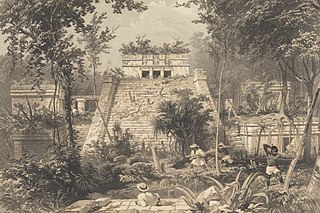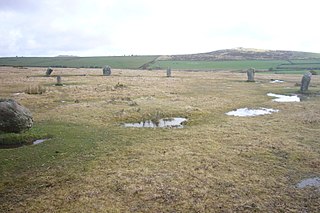Related Research Articles

Below are notable events in archaeology that occurred in 1877.

Prehistoric archaeology is a subfield of archaeology, which deals specifically with artefacts, civilisations and other materials from societies that existed before any form of writing system or historical record. Often the field focuses on ages such as the Stone Age, Bronze Age and Iron Age, although it also encompasses periods such as the Neolithic. The study of prehistoric archaeology reflects the cultural concerns of modern society by showing interpretations of time between economic growth and political stability. It is related to other disciplines such as geology, biology, anthropology, historiography and palaeontology, although there are noticeable differences between the subjects they all broadly study to understand; the past, either organic or inorganic or the lives of humans. Prehistoric archaeology is also sometimes termed as anthropological archaeology because of its indirect traces with complex patterns.

The Archaeological Survey of India (ASI) is an Indian government agency that is responsible for archaeological research and the conservation and preservation of cultural historical monuments in the country. It was founded in 1861 by Alexander Cunningham during the British Raj who also became its first Director-General.

Below are notable events in archaeology that occurred in 1844.
Below are notable events in archaeology that occurred in 1894.
Below are notable events in archaeology that occurred in 1896.
The year 1963 in archaeology involved some significant events.
Courtenay Arthur Ralegh Radford was an English archaeologist and historian who pioneered the exploration of the Dark Ages of Britain and popularised his findings in many official guides and surveys for the Office of Works. His scholarly work appeared in articles in the major British journals, such as Medieval Archaeology or the Proceedings of the British Academy and in the various Transactions of archaeological societies.
The decade of the 1700s in archaeology involved some significant events.

Thomas Ashby, was a British archaeologist and director of the British School at Rome.

Rev. William Collings Lukis MA. FSA was a British antiquarian, archeologist and polymath.
Christian Maclagan was a Scottish antiquarian and early archaeologist, described by one author as "the earliest female archaeologist in the British Isles," and certainly among the earliest examples. She is known for her collection of rubbings of Celtic crosses and Pictish stones from across Scotland, and was a pioneer of stratigraphic excavation. Although she lost the use of her right hand due to a medical condition she nevertheless produced numerous drawings, sketches and paintings with her left hand. She took action to help those affected by poverty in Stirling. She refused to sit for portraits although one obituary described her as tall. She was a suffragist. She wrote an autobiography but the script remains lost. She was nominated to be one of Scotland's Heroines honoured at the National Wallace Monument's Hall of Heroes.

Duloe stone circle or Duloe circle is a stone circle near the village of Duloe, located 5 miles (8.0 km) from Looe in southeast Cornwall, England, UK.

Fernacre, also known as Fernacre stone circle or Fernacre circle, is a stone circle located on the slopes of the De Lank River, 1.25 miles (2.01 km) northeast of St Breward on Bodmin Moor in Cornwall in the United Kingdom.
Goodaver, Goodaver stone circle or Goodaver circle is a stone circle located in the parish of Altarnun, near Bolventor on Bodmin Moor in Cornwall.

The Trippet stones or Trippet stones circle is a stone circle located on Manor Common in Blisland, 9 kilometres (5.6 mi) north northeast of Bodmin on Bodmin Moor in Cornwall, UK. The Stripple stones are nearby.

The Stripple stones is a henge and stone circle located on the south slope of Hawk's Tor, Blisland, 10 kilometres (6.2 mi) north northeast of Bodmin on Bodmin Moor in Cornwall, England, UK.

The Nine Stones is a stone circle 3 kilometres (1.9 mi) south southeast of Altarnun, 11 kilometres (6.8 mi) west of Launceston on Bodmin Moor in Cornwall, UK.
David John Breeze, OBE, FSA, FRSE, HonFSAScot, Hon MIFA is a British archaeologist, teacher and scholar of Hadrian's Wall, the Antonine Wall and the Roman army. He studied under Eric Birley and is a member of the so-called "Durham School" of archaeology. He was a close friend and colleague of the late Dr Brian Dobson.
David Hilary Trump was a British archaeologist known for his work in the area of Maltese prehistory. In 1954, Trump helped John Davies Evans excavate at Ġgantija. He took part in the excavation of many important sites in Maltese prehistory, including the Skorba Temples and Xagħra Stone Circle. From 1958–1963, he was a curator at the National Museum of Archaeology, Malta. He retired in 1997. He was awarded the National Order of Merit by Malta in 2004.
References
- ↑ "Beazley, J[ohn] D[avidson], Sir". Dictionary of Art Historians. Archived from the original on 21 July 2012. Retrieved 14 June 2012.
- ↑ "Alfred V. Kidder". Britannica.com. Retrieved 27 May 2017.